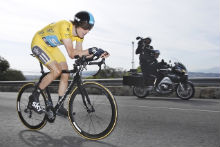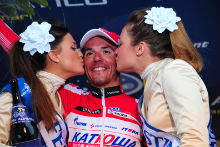March is only weeks away, bringing with it the start of the sportive season.
Events like the Wiggle Cheshire Cat, the Trek Endura Lionheart, and the Alutra Spring Onion loom large on the calendar, but only six weeks on from the excesses of the festive season, and perhaps less until many roll out for their first event, fitness and confidence levels are perhaps lower than desired. How to build up the endurance necessary for the first big ride of the year in so short a time?
We asked three successful coaches for their ingredients on the ideal endurance ride, to make the most of your time in the saddle. John Capelin is qualified at Level Four with the Association of British Cycling Coaches, while professional cyclist turned coach, Dave Lloyd, a two-time national champion, once a member of the vaunted Raleigh-Ti road race squad, has finished La Marmotte as the fastest rider in his age group since turning his attention to sportives. Marc Laithwaite has a BSC in sports science, and is studying for a PhD. He is qualified at level three with the Association of British Cycling Coaches.
The temptation to log training miles as evidence of an effective training regime is understandable, but one to be avoided, according to our three experts. Lloyd puts it simply: “The number of miles doesn’t matter. If you’re training on hills, for example, you will be working harder than riding on the flat.” Laithwaite also highlights the influence of hills, and highlights the possible impact of machinery on the amount of miles covered. Capelin warns that “chasing miles” develops a tendency to work on speed rather than endurance, and cautions against “microwave training” – trying to cram two hours of effort into one hour’s riding. “The key is to enjoy what you’re doing. If you try to ‘time crush’ you tend to do things badly or train way too hard. Keep it low level. Generally, people get out and train too hard, and they don’t get better.”
Low intensity endurance work and high intensity interval training sit at opposite ends of the training spectrum.
Do the two approaches serve different training goals, or can both be used to establish a base level of fitness? Laithwaite argues that they are not mutually exclusive. Endurance work should be the starting point at any attempt to build a base level of fitness, he says, but adds, “interval training does have a role in determining ‘how quick’ those endurance rides will be. Long slow rides should be completed at approximately 60 per cent of your maximum, so if you have a high maximum, then 60 percent still works out pretty well and you’ll be moving relatively quickly, even on your endurance rides. By comparison, if your maximum is low, then 60 per cent of a ‘low maximum’ will see you riding pretty slowly.” Capelin agrees that endurance work must come first. “It depends on your goal, but at this time of year, you tend to focus on building an endurance base. There’s time to add speed to that,” he says.
For many riders preparing for a sportive, time is at a premium. Training time is often squeezed by professional and domestic commitments, and too often weekends are the only time available to train. Can the ‘weekend warrior’ ever develop sufficient fitness for the goal of completing a sportive? Or is extra work during the week essential to developing the requisite endurance levels?
Capelin says a surprising amount of people achieve results by riding on Saturdays and Sundays, but urges the time-pressed to find a space in their weekday schedules. “That one extra ride in the week will make all the difference. I have lots of London-based clients out at 5am and 6am, riding around Richmond Park. They are not doing anything special, but they are on their way to work and squeezing in an extra session. At this time of year, you can put in a session on the turbo trainer and make further gains,” he says. Laithwaite makes a similar point: “Weekends are ideal as you have more time, but ultimately one ride per week is just not enough. Unless there is ice on the roads, there’s no reason why you can’t wrap up, buy some decent lights and get out in the evenings to build the miles,” he says.
For Lloyd, a planned approach can help even the most time-pressed rider. “A structured plan will make sure that every hour on the bike counts. Some guys go out and blast it like it’s the last training ride they’ll ever do. Be honest with yourself and be honest with your coach,” he says.
Planning a route for your training time will also help make the most effective use of those precious hours. But what profile should it take? Should you stick to the flat or will undulating terrain help develop your fitness faster? Is hill work essential to becoming a better climber? And is a repeatable circuit a useful measuring stick, or simply dull and demotivating?
Laithwaite says flat terrain is more beneficial for heart rate based endurance training. “If your heart rate is spiking and dropping throughout the ride, the aerobic conditioning is poor. Average heart rate is a pointless figure. You can spend 50 per cent of your ride going uphill with a heart rate of 160bpm and 50 per cent of your ride going downhill with a heart rate of 90bpm and kid yourself that your ‘average’ was 125bpm,” he says. “The key figure is ‘time in zone’ or ‘time at target heart rate’. How much time did you actually spend at 125bpm? Flatter courses are much better for heart rate control so for now, if base is your focus, avoid the hilly routes… just for now!”
For Capelin, “serious” climbs should be avoided for effective early season training. “For interest, it’s best to ride on a mix of terrain, but for basic endurance, flat or gentle hills are fine, but nothing too serious. It’s a complete misnomer to think that to climb mountains you have to ride a lot of hills. It’s about strength,” he says.
Training alone or with a group can add a different dynamic to your preparation. Riding alone will guarantee focus once on the bike, but can make it easier to miss a session if you have to justify your absence to no-one but yourself. Conversely, the camaraderie of a group session can raise motivation, but also prove a distraction from the task at hand.
“For interval training, you’re better off riding alone, but for endurance, as long as no-one is racing, and you’re all committed to low level training, it’s more fun to train with someone,” says Capelin. “It’s just good fun to ride along chatting, and if you can chat to someone, you’re in the right zone. If you can’t chat, you’re trying too hard. Another benefit is riding close to others in a group, which you’ll be doing in a sportive, so you’ll be improving your technique as well as your endurance.” Laithwaite stresses the importance of concentrating on your own goals, even if your riding companions have other aims. “Riding in a group is great so long as you maintain your own focus and hit your objectives. Most groups race up hills and then free wheel down the other side which results in the problem controlling heart rate as outlined above. Group riding is very positive, but stick to your own objectives,” he says.
Lloyd also stresses the importance of sticking to your goals. The cafe stop is something he “abhors” and recommends riding on alone if training buddies are tempted to waste precious time on the bike indulging in coffee and cake. He likens base training to digging the foundations of a house. “The deeper you go, the higher you can build, and the better the top end of your performance will be,” he says. “If you don’t develop your base fitness, it’s like a building a house without foundations – it will fall down. If you haven’t got a base of “zone two” work – 65 per cent of your maximum heart rate – when you start putting interval work on top, you won’t have the legs.”





